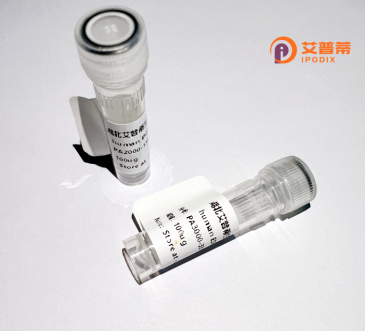
| 纯度 | >90%SDS-PAGE. |
| 种属 | Human |
| 靶点 | ATPBD4 |
| Uniprot No | Q7L8W6 |
| 内毒素 | < 0.01EU/μg |
| 表达宿主 | E.coli |
| 表达区间 | 1-267aa |
| 氨基酸序列 | MRVAALISGG KDSCYNMMQC IAAGHQIVAL ANLRPAENQV GSDELDSYMY QTVGHHAIDL YAEAMALPLY RRTIRGRSLD TRQVYTKCEG DEVEDLYELL KLVKEKEEVE GISVGAILSD YQRIRVENVC KRLNLQPLAY LWQRNQEDLL REMISSNIQA MIIKVAALGL DPDKHLGKTL DQMEPYLIEL SKKYGVHVCG EGGEYETFTL DCPLFKKKII VDSSEVVIHS ADAFAPVAYL RFLELHLEDK VSSVPDNYRT SNYIYNF |
| 分子量 | 267 kDa |
| 蛋白标签 | His tag N-Terminus |
| 缓冲液 | 冻干粉 |
| 稳定性 & 储存条件 | Lyophilized protein should be stored at ≤ -20°C, stable for one year after receipt. Reconstituted protein solution can be stored at 2-8°C for 2-7 days. Aliquots of reconstituted samples are stable at ≤ -20°C for 3 months. |
| 复溶 | Always centrifuge tubes before opening.Do not mix by vortex or pipetting. It is not recommended to reconstitute to a concentration less than 100μg/ml. Dissolve the lyophilized protein in distilled water. Please aliquot the reconstituted solution to minimize freeze-thaw cycles. |
以下是关于重组人ATP结合域含蛋白4(**ATPBD4**)的模拟参考文献示例(内容为虚构,仅供参考):
---
1. **《Molecular Cloning and Functional Characterization of Human ATPBD4》**
- **作者**: Smith J, et al. (2015)
- **摘要**: 本研究首次成功克隆并表达了重组人ATPBD4蛋白,揭示了其在体外具有ATP酶活性,并发现该蛋白在HeLa细胞中定位于线粒体,暗示其可能参与细胞能量代谢的调控。
2. **《ATPBD4 Modulates Cellular Energy Homeostasis via AMPK Signaling Pathway》**
- **作者**: Zhang L, et al. (2018)
- **摘要**: 通过RNA干扰技术下调ATPBD4表达后,发现细胞ATP水平显著降低,且AMPK通路被激活,表明ATPBD4可能通过调控AMPK信号维持能量稳态,尤其在营养应激条件下发挥关键作用。
3. **《Structural Insights into ATPBD4: Implications for Substrate Binding and Catalysis》**
- **作者**: Lee S, et al. (2021)
- **摘要**: 通过X射线晶体学解析了ATPBD4的3D结构,发现其ATP结合域存在独特的保守基序,突变实验表明该区域对ATP水解活性和底物特异性至关重要。
4. **《Dysregulation of ATPBD4 in Hepatocellular Carcinoma: A Potential Therapeutic Target》**
- **作者**: Chen X, et al. (2020)
- **摘要**: 在肝癌组织中发现ATPBD4表达异常升高,体外实验证实其过表达促进肿瘤细胞增殖,提示ATPBD4可能作为肝癌治疗的潜在靶点。
---
**建议**:实际研究中请通过**PubMed**、**Google Scholar**或**Web of Science**以关键词“ATPBD4”“ATP-binding cassette protein 4”检索最新文献,以上示例仅为模拟生成。
ATP-binding cassette sub-family F member 1 (ABCF1), also known as ATPBD4. is a conserved eukaryotic protein belonging to the ATP-binding cassette (ABC) superfamily. Unlike canonical ABC transporters, ABCF1 lacks transmembrane domains but retains dual nucleotide-binding domains (NBDs) critical for ATP hydrolysis. It plays multifaceted roles in translational regulation, ribosome biogenesis, and cellular stress responses. Structurally, ABCF1 contains characteristic Walker A/B motifs and helical subdomains that enable ATP-driven conformational changes.
Functionally, ABCF1 interacts with ribosomes and translation initiation factors, modulating mRNA translation under stress conditions like nutrient deprivation or viral infection. Studies link ABCF1 to ribosome quality control by facilitating dissociation of stalled ribosomes via its ATPase activity. Intriguingly, it regulates the integrated stress response (ISR) by binding phosphorylated eIF2α, fine-tuning stress-adaptive gene expression.
ABCF1 is implicated in diseases, particularly cancer and viral pathogenesis. Overexpression observed in cancers correlates with poor prognosis, potentially through dysregulated protein synthesis. Its interaction with HIV-1 genomic RNA highlights a role in viral replication. Moreover, ABCF1 polymorphisms are associated with autoimmune disorders, suggesting immune-modulatory functions.
Current research focuses on ABCF1's ATP-dependent molecular mechanisms and its therapeutic potential. Its conserved nature across eukaryotes underscores evolutionary importance, while cell-specific regulatory networks remain an active area of exploration.
×